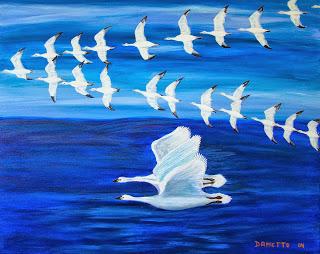 Now is the time! Have you thought about how a bird migrates and why. The following will provide you with information regarding bird migration as to why, how, and where. Depending on your location you will be able to see these species traveling to or from their destinations and develop an appreciation for the phenomenon of migrating birds.
Now is the time! Have you thought about how a bird migrates and why. The following will provide you with information regarding bird migration as to why, how, and where. Depending on your location you will be able to see these species traveling to or from their destinations and develop an appreciation for the phenomenon of migrating birds.Bird migration is the regular seasonal journey made by many species of birds in response to their decrease in resources such as food and shelter by the changing seasons. The primary reason for migration or movement is food; for example, some birds may choose not to migrate if they are fed through the cold months. Changes in the day length are cues for migration and relate to the hormonal changes in the birds. Birds will also display restlessness and increase their fat deposition. During shorter days in the fall, birds will return to warmer areas where they find adequate food supply. The advantages of migrating/movement of birds offset the high physical exertion and other risks of the travel. Many smaller insect eating birds migrate large distances and usually at night. They may feed for a few days before resuming their course of travel. An advantage for night migrating is that it minimizes the threat of predators, allowing the birds to feed during the day and avoid overheating.
Navigation for this transition are based on a number of different senses. Many birds use the sun as a compass which involves compensation based on the time. The ability to detect magnetic fields, use of visual landmarks, as well as their sense of smell are used to help navigate during migration. Bird migration is a strong genetic component in terms of timing and route, which can be influenced by environmental changes. The most critical weather factors are wind direction and changes in temperature. Migratory birds may use two tools to find their destinations: innate (genetically programmed) and experience. A first-timer migrant flies according to the Earth's magnetic field, but does not know how far it will take until it grows accustomed to the journey and be able to utilize it’s other capabilities. With experience they learn various landmarks often called "mapping". The magnetic fields differs at different latitudes allowing the bird to know when it has reached its destination.
Migration is primarily seen in the Northern Hemisphere and less obvious in the Southern Hemisphere. This is due to the lack of significant weather changes and the continual supply of food for the birds. A common pattern in migration involves flying north in the spring to breed during the summer and traveling to the south in the fall into warmer regions. No two species follow the exact route from beginning to end. Migrations narrow into one or more preferred routes or often called “flyways”. Flyways primarily follow coasts, sometimes rivers, or mountain ranges, and may take advantage of updrafts and other wind patterns or avoid barriers like large stretches of open water and can be different during the return migration. There are four major North American flyways: the Atlantic, the Mississippi, the Central and the Pacific Flyways. The flyways are not defined in its boundaries and at times may merge into one.
How can you impact this phenomenon? Long distance migrants disperse as young birds and form attachments to potential breeding and wintering sites. Once the site attachment is made birds show high site-fidelity, visiting the same sites year after year. You will want to ensure your nesting boxes are cleaned out and available when these birds return to keep the cycle going for these migrating species.
